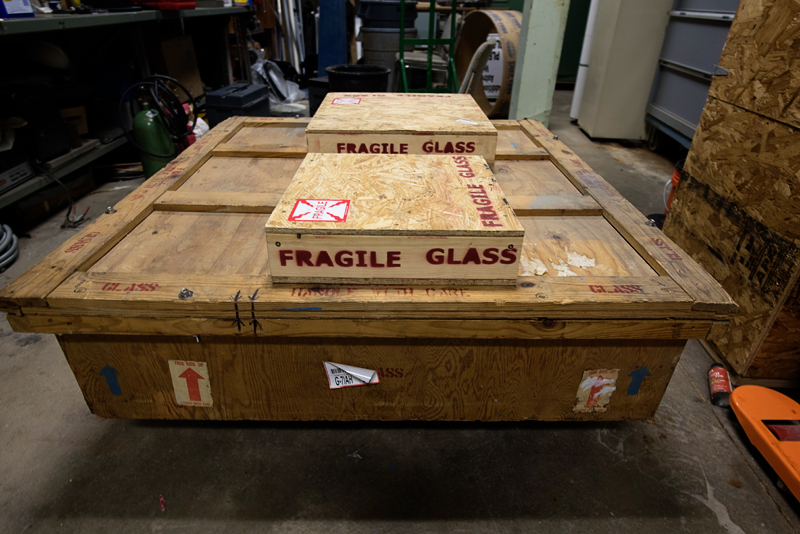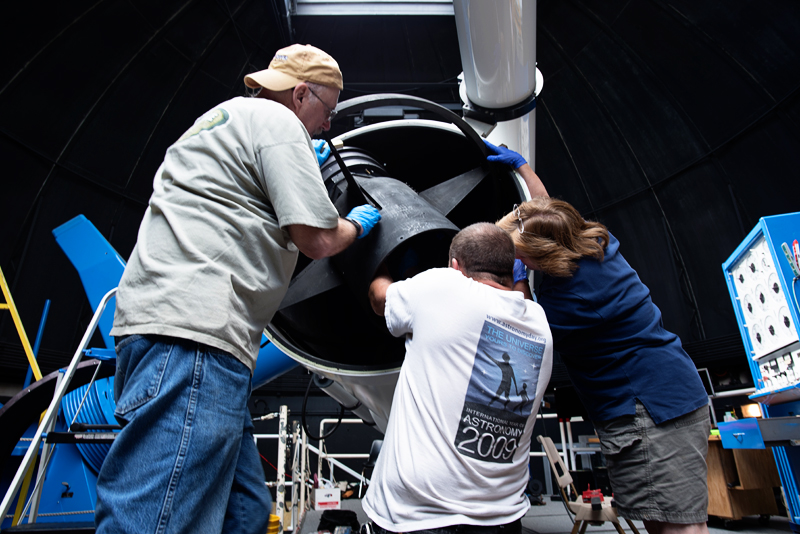April 25 will mark the 25th anniversary of the world-famous Hubble Space Telescope, and the George Observatory will celebrate with a debut of their restored 36-inch Gueymard Research Telescope, the largest specialized Cassegrain telescope open to the public, and the only one that chooses to use an eyepiece.
“You can see the images with your own eyes instead of on a computer screen like other telescopes,” George Observatory Director Peggy Halford said. “It gives you a much more personal experience.”
A Ritchey—Chretien design, the telescope features hyperbolic primary and secondary mirrors which sharpen the image, eliminating the fuzzy edges around its center, what is known to astronomers as an off-axis coma. With optics this precise, the telescope brings to the naked eye the phenomena of deep space.
A couple of years ago, astronomers at the George began to notice the quality of images in the Gueymard was degrading. Views were clearer in the smaller, though still research-grade, 11-inch refractor attached to the Gueymard. While they knew something was wrong, they didn’t expect the adventure they would embark upon to restore it to its original power.
When they removed the primary mirror, the equivalent of “checking under the hood,” they found environmental pollutants built up in microscopic divots and fissures left on its surface after its original grind 50 years ago. Optical technology has come a long way since then; imperfections in contemporary optics are virtually absent, Halford said. The George acquired the telescope from Louisiana State University, where it had stood in swamp-like conditions another 25 years prior to its installation in Brazos Bend State Park. Time and humidity had taken its toll.
The Museum sent the delicate 500-pound mirror to a coating company that did the simple things first — a bath and a new reflective coating — to try to refurbish the mirror, but the coating refused to stick, and they knew they would need to bring in the big guns.

The wooden container the George employees used to ship the hyperbolic mirror.
It took a three-month fundraising campaign, Save Our Scope, to raise the money to hire Master Optician James Mulherin to resurface the element. Halford is proud to report the campaign took much less time than she anticipated, given the surprising amount of support from the public.
February 2014, the George again sent mirror away, this time to Mulherin, and a year an a month later, the project was complete. Mulherin took a trip to the George to help install the element, and he sat down to explain the particulars of the resurfacing project and what he does at his business, Optical Mechanics, Incorporated.
One of two specialists in the nation who do this kind of work, Mulherin came highly recommended from amateur astronomers who dropped his name to Halford at star parties when they learned of the George’s difficulty with the Gueymard. What was tough for the astronomers was a piece of cake for Mulherin.
“It was a fairly routine job,” said Mulherin, whom universities and aerospace companies regularly hire for their optical needs. “There was no real challenge.”
Mulherin did mention, however, that he had to work around the hole in the middle of the mirror, where a steel hub goes through to hold the mirror in place at the bottom of the telescope. Normally a glass plug is installed during the grinding phase, but there was too much difference in the composition of this 50-year-old glass and that of contemporary optics, he said, so he had to work around it.
Using specialized equipment to move the delicate, but massive, hunk of glass, Mulherin’s company stripped the aluminum finish and ground down the old surface to remove the imperfections in the element. The opticians then re-shaped the mirror’s hyperbolic curvature, shining light through the glass at different stages to check their progress. Finally, Mulherin coated the surface with enhanced aluminum to increase reflectivity.

The George will debut the repaired Gueymard April 25, coinciding with the 25th anniversary of the Hubble Space Telescope.
The result was a total restoration of the optics, but volunteers still had to put the mirror back into place. The replacement, including the removal of the cement blank used to counterbalance the telescope while the mirror was out, along with cleaning the housing, took Tracy Knauss, Dana Lambert and Chris Randall 10 days straight, working from noon to 10 p.m.
Changes to the width of the mirror required volunteers to adjust the secondary mirrors after the installation of the main element — no small task. Installation and adjustments of the precision optics continued from 8 a.m. to 10 p.m. Monday, and again Tuesday from noon to 10 p.m.
“I wanted to stick an eyepiece into it and it work,” Halford said, but collimating the telescope, or aligning the elements with accuracy, required much more time.
Mulherin said he felt at home at the George during the course of the project, and happy to help.
“I feel like I’m part of the community,” he said. “When I started, we were all amateur astronomers, and I found I was more interested in optics than astronomy.”
About the telescope, he said, “It’s amazing to me that it still works.”
Halford hopes for clear skies April 25, but if conditions turn cloudy, she said, “We’ll just show it off.” The George will observe regular Saturday hours from 3 to 10 p.m. for the event.
First Light & 25th Anniversary of the Hubble Space Telescope Celebration
Saturday, April 25
3:00 p.m. – 10:00 p.m.
April 25 will mark the 25th anniversary of the world-famous Hubble Space Telescope, and the George Observatory will celebrate with a debut of their restored 36-inch Gueymard Research Telescope, the largest specialized Cassegrain telescope open to the public, and the only one that chooses to use an eyepiece.








